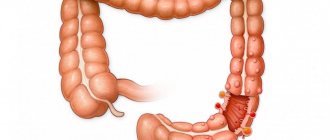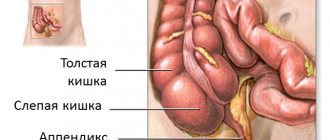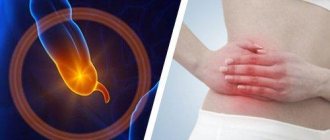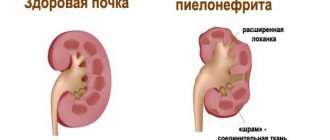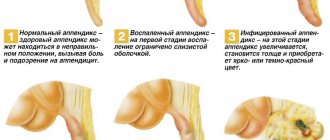Symptoms of appendicitis in men have classic manifestations, which are associated with the anatomy of the internal organs. The appendix is a rudimentary extension of the cecum; it has the appearance of a hollow tubular organ with a cavity communicating with the intestine. In accordance with the male anatomical structure of the body, it is located in the lower right abdomen. This region is called the ileum. When an inflammatory process occurs, a number of signs of appendicitis in men occur.
Concept and classification
Appendicitis is a disease that develops as a result of inflammatory changes in the appendix.
In men, acute appendicitis is usually expressed by more pronounced symptoms than in women; it can be easily diagnosed even at home
The pathology is classified as follows:
- For changes affecting the appendix:
- catarrhal, or superficial;
- phlegmonous;
- gangrenous;
- perforated.
- According to the prevalence of inflammatory changes:
- uncomplicated;
- complicated: appendicular infiltrate;
- appendicular abscess;
- local peritonitis;
- diffuse peritonitis;
- other complications, for example, interintestinal abscesses.
- According to symptoms:
- with typical signs;
- with an atypical course: dysuric disorders;
- manifestation of gallbladder diseases;
- diarrhea;
- pronounced increase in temperature;
- severe purulent intoxication.
The appendix is a hollow organ connected to the cecum. Its length is about 10 cm, diameter - 1 cm.
Almost always the process is localized in the right iliac region (hypogastrium), but its position can be very different - the variety of symptoms of the disease depends on this. The location of the process does not depend on the gender and age of the person.
Location options:
- Typical:
- descending - downward from the cecum;
- lateral - to the right of the cecum;
- anterior - anterior to the intestine;
- Atypical:
- retrocecal - posterior to the cecum, for example, when the appendage is completely located in the fat cell of the retroperitoneal space;
- pelvic - the cecum is low or the appendage is of considerable length;
- medial - to the left of the cecum;
- subhepatic - the cecum is located high or a process of considerable length is directed upward;
- left-sided - occurs extremely rarely with inversion (transposition), when all organs have a mirror position, including the cecum with the appendix.
The role of the appendix
The main function of the entire digestive tract is to digest food. The appendix does not take any part in the process, so the question of its direct significance remains open.
There is an assumption that due to the lymphatic tissue developed in this area, the process plays an important role in the formation of immunity.
According to some authors, the appendix is a source of normal bacterial flora for the intestines, especially after infections.
Features of the course of the disease
The primary symptoms of appendicitis in men are standard: abdominal pain, nausea, sometimes vomiting, fever, and general condition worsening. But during the catarrhal stage of the disease, specific symptoms appear:
- difference in temperature in the armpit and anus;
- pain radiating to the right testicle with pressure on the scrotum;
- when you press on the painful point of the iliac region, the right testicle moves;
- upon visual examination, elevation of the right testicle is noted due to muscle spasm from the vermiform appendix;
- diffuse nature of pain at the initial stage of development of the disease with its subsequent concentration in the right iliac region (Kocher’s symptom):
- low-grade fever (not higher than 37.5°C);
- nausea, vomiting, weakness.
In the first half of the day from the onset of development of catarrhal changes in the appendix, the symptoms of intoxication are mild and the man’s state of health is satisfactory.
The transition of the catarrhal form of appendicitis to the fibrotic stage of the process significantly worsens the patient’s condition. Intoxication of the body intensifies, clinical manifestations are supplemented by the following symptoms:
- fever with temperature up to 38.5-39°C;
- pain that becomes throbbing;
- the appearance of swelling;
- nausea with no vomiting;
- cold sweat;
- tachycardia;
- pale skin;
- tension of the anterior abdominal wall;
- participation of the intercostal muscles of the chest in the act of breathing.
The development of the disease and the transition of appendicitis to the gangrenous form in a man are manifested by a further increase in general intoxication of the body with the following clinical picture:
- heat;
- chills;
- cold sweat;
- vomiting that becomes indomitable;
- dryness of the oral mucosa;
- pulse up to 120 beats per minute;
- drop in blood pressure to 80-90 mm Hg. Art.;
- severe weakness;
- inhibited state.
If medical assistance is not provided, acute gangrenous appendicitis progresses to the next, perforated form. In this case, the purulent contents of the appendix break through its walls and pour into the abdominal cavity with the subsequent development of peritonitis.
A breakthrough of the abscess is accompanied by sharp and unbearable pain with an increase in symptoms of intoxication. This condition requires emergency surgery. Often patients with such pathologically rapid development of appendicitis die from general intoxication.
Specifics of the development of pathology in adult men and women
A feature of the development of the disease in women is the location of the appendix in close proximity to the uterine appendages. If an inflammatory process forms in them, changes can also affect the appendix. But when the underlying pathology in the ovary and fallopian tube is eliminated, abnormal transformations in the appendix also disappear.
Statistical data indicate a more frequent occurrence of acute inflammatory process in the appendix in young boys and young men (on average up to 20 years). With age, the incidence decreases by almost half. Sometimes, due to a careless attitude towards his health, a man develops chronic inflammation, which bothers him for years.
About appendicitis
Modern adult humans have the appendix as a vestigial organ. However, some doctors believe that in young children the appendix is a fully functioning organ related to the immune system. Therefore, it should not be removed at a young age, so as not to provoke delays in the development of the body. However, such a statement is only a hypothesis that has not received practical confirmation.
Appendicitis most often begins to appear in people after 10 years of age. Statistics show the following figures for the number of cases:
- In 15% of people, the appendix becomes inflamed by age 15;
- 25% of cases of the disease were observed in people over 20 years of age;
- 45% of thirty-year-olds are susceptible to inflammation.
As can be seen from the statistics, inflammation of the appendix, called appendicitis, does not occur in everyone.
Doctors have found out what is the most effective remedy for worms! According to statistics, every 5 Russians have worms. Read on for a recipe that will help cleanse your body of worms in just 7 days.
If you seek medical help in time, you can get rid of the consequences of the disease within a week. This period seems to be very short for diseases that can be solved surgically. However, such a quick recovery period is only possible if you consult a doctor in a timely manner. If time is lost, the patient may experience blood poisoning, which will cause the patient’s quick death.
Causes and risk factors
The inflammatory process in the appendix begins with its blockage, which develops due to:
- the presence of fecal stones - dense formations that form when stool is retained, for example, with constipation, impaired peristalsis;
- tumors of the intestine or surrounding organs;
- compression of the process from the outside, for example, with lymphadenitis;
- hyperplasia of lymphoid tissue inside the appendix;
- parasitic infestation;
- undigested food debris, such as grape seeds.
Factors contributing to the development of the inflammatory process:
- the presence of chronic foci of infection;
- systematic violation of the act of defecation;
- congenital developmental anomalies;
- suppressed immunity.
Taking into account the causes of the disease and predisposing factors, patients at risk are identified. These are men with chronic infectious pathologies and slow intestinal motility.
Symptoms and first signs
With a typical location of the appendix at the onset of the disease, the following is observed:
- nausea;
- one-time vomiting;
- stool liquefaction;
- general malaise;
- temperature rise;
- coating on the tongue and dry tongue.
In the first few hours, the temperature is subfebrile (not higher than 38 °C), but with the development of phlegmonous, gangrenous or complicated appendicitis, it immediately rises to high numbers.
The main manifestation of the pathology is pain, which is present in 100% of cases: constant aching, gradually increasing, pulsating. Lying on the sore side becomes easier - the discomfort decreases. Based on the nature of the pain and its distinctive features, the surgeon identifies the form of appendicitis.
In case of appendicitis, it is almost impossible to relieve pain with the help of analgesics, and the use of antispasmodic drugs can provoke a worsening of the condition
Table of main manifestations
| Symptom | Description | Development mechanism |
| Kocher | Pain in the epigastrium in the initial stages of the disease is replaced by pain in the right hypogastrium | Some experts suggest that the cause is a concomitant disruption of the pancreas. Others talk about “referred” pain due to the duration of the pain syndrome. This is a 100% sign of appendicitis |
| Shchetkin-Blumberg | Painful sensations appear or become more intense when the hand is abruptly removed after pressing in the area of the projection of the appendix | Concussion of organs, including the appendix, provokes pain. Peritonitis is diagnosed in 98% of cases |
| Sitkovsky | Pain worsens on the left side in a horizontal position | When the intestine is displaced, the mesentery of the appendix is stretched, and the pain intensifies |
| Krymova | There is pain when palpating the peritoneum through the external opening of the right inguinal canal | The peritoneum is the thin membrane of the abdominal cavity that lines its inner walls. It forms a fold and fixes the process to the cecum and small intestine. Therefore, when palpating the peritoneum, the process moves |
| Dumbadze | The pain becomes more intense when palpating the peritoneum through the navel | Same as Krymov's symptom |
| Obraztsova | When examining the abdomen with the right leg elevated while lying on the back, severe pain is detected | Raising the leg causes tension in the iliacus muscles, making the process more accessible to palpation, which in turn increases pain. |
| Kushnirenko | Pain when coughing | The pain becomes more intense due to increased pressure in the abdominal cavity |
| Yaure-Rozanova | Pain when pressing on the right iliac crest | When pressure is applied, some displacement of the ascending colon occurs along with the cecum and appendix. This is a sign of chronic inflammation |
| Barona | Unpleasant or painful sensations when palpating the right lumbar muscle | The cecum lies on the iliacus muscle, so there is direct irritation of the appendix, which causes pain. Sign of chronic appendicitis |
| Britten | When palpating the area of the appendix, the right testicle retracts, that is, it is “pulled up” into the inguinal canal | This occurs due to protective muscle tension |
| Kümmel point | Pain 2 cm to the right and below the navel | Pain is associated with the presence of nerve fibers in this area |
The symptoms of atypical inflammation of the appendix in men are difficult due to their similarity with the manifestations of other pathologies.
- Retrocecal appendicitis:
- pain slightly above or below the right hypogastrium (on the right side);
- the Yaure-Rozanov symptom is determined, characterized by pain in the lower back on the right;
- Cobrak's symptom is expressed: palpable pain during examination through the rectum, when the doctor presses up and to the right.
- Pelvic appendicitis:
- lack of tension in the abdominal muscles;
- pain during examination through the rectum;
- increased sensitivity of the anus;
- frequent painful stool and urination;
- Soupeau-Seye's symptom: when taking a deep breath, unpleasant sensations appear in the projection of the bladder.
- Medial location of the appendix:
- significant pain syndrome;
- its distribution throughout the intestines;
- repeated vomiting, loose stools.
- Left-sided location of the process:
- the pain is localized in the left hypogastrium;
- an additional sign is inversion of all organs, for example, the heart is on the right, which may suggest an atypical position of the appendix.
Features of the clinical course in children and the elderly
Acute appendicitis in children develops with severe general symptoms:
- a significant rise in temperature;
- intoxication;
- tachycardia.
It is especially important to see a doctor in a timely manner and correct diagnosis, because the process develops much faster than in adult men. There is a certain pattern: the younger the child, the more severe the pathology. Besides:
- mandatory hospitalization is recommended, even if the diagnosis is unclear;
- At any stage of the process, surgical treatment is performed.
Elderly people are characterized by a mild, unexpressed course of the disease. General and local manifestations may be absent even in severe forms.
Signs of chronic appendicitis: what are they?
The difficulty of diagnosing this pathology is its polymorphism, that is, there are many symptoms, but they are either insignificant or atypical.
A constant companion of chronic appendicitis in men is pain:
- aching or periodic cramping;
- localized in a typical place or peri-umbilical area;
- spreading to the right thigh, perineum or lower back;
- worsens with exercise, coughing, sneezing;
- accompanied by a violation of the act of defecation.
You need to pay close attention to the chronic form, because it can become acute, the course of which is more severe.
Appendix and appendicitis - how not to miss a dangerous disease (video)
Doctor's arrival
An experienced medical professional can easily identify an attack and diagnose it by observing the manifestations from the outside. External signs and special studies - laparoscopy, x-rays, ultrasound - help to quickly understand the situation.
The doctor must make a diagnosis and prescribe treatment, take immediate measures to normalize the patient’s condition.
The ambulance takes the patient to the hospital, where emergency diagnostics are carried out and treatment is prescribed. If there is pain on the side of the right rib, in the lower abdomen, and appendicitis is diagnosed, the only way out is to have surgery. Today there are no medications that would eliminate this need; surgery remains an exceptional way to help a person. Help is urgently needed, because appendicitis is a dangerous phenomenon that can lead to death, peritonitis, and abscesses. The disease leads to purulent phenomena, intestinal rupture, and fistulas in the abdominal cavity. The main thing that can and should be done for the patient is to call a doctor, self-medication is excluded, time is ticking. Failure to see a doctor in a timely manner significantly complicates the treatment process; a ruptured appendix pours pus into the abdominal cavity, and doctors are faced not only with the need to remove the appendix, but also with cleaning the cavity from pus.
Diagnosis of acute and chronic forms
Diagnostic measures include:
- Questioning and examination by a doctor, after which, in most cases, appendicitis will be suspected.
- Laboratory blood tests:
- an increase in the relative number of leukocytes in a general blood test;
- accelerated ESR (erythrocyte sedimentation rate);
- coagulogram in preparation for surgery;
- blood type and Rh factor.
- Functional diagnostics:
- ultrasound examination of the abdominal organs;
- ECG (electrocardiography).
If after the study the doctor still has doubts about the diagnosis, additional measures are taken:
- Blood chemistry.
- General clinical urine analysis.
- X-ray of the abdomen and chest.
- Diagnostic laparoscopy.
The fundamental point in determining appendicitis is early admission to the hospital. When the process is delayed, the risk of complications increases, because the typical manifestations of the pathology begin to fade.
How to distinguish appendicitis from other pathologies?
When carrying out differential diagnosis, the main symptom is pain.
Symptomatic table of diseases
| Disease | Nature of pain and other associated symptoms |
| Crohn's disease | 1. Constant increasing or cramping pain. 2. Bloating, increased peristalsis. 3. Frequent loose stools with mucus and blood. 4. Pain does not disappear for several years. |
| Mesenteric lymphadenitis | 1. Occurs against the background of a viral infection. 2. Most often observed in children and adolescents. 3. The pain has no clear localization, so the patient cannot say where it started. 4. The temperature rises to high numbers. 5. Symptoms of intoxication are present (before pain appears). |
| Bacterial enterocolitis | 1. Cramping non-localized pain, often starting from the umbilical area. 2. The occurrence of the disease is associated with the intake of low-quality products. 3. Accompanied by lymphadenitis, vomiting, diarrhea. |
| Urolithiasis disease | 1. Sharp cutting pain along the ureter or in the lumbar region. 2. Frequent urination in small portions, burning sensation. 3. Nausea, vomiting. |
| Perforation of a gastric or duodenal ulcer | 1. Acute, sudden, sharply increasing pain. 2. Severe intoxication. 3. Abdominal muscle tension. 4. History of pain associated with eating, heartburn. |
| Acute pancreatitis | 1. Pain begins in the upper abdomen and has a girdling character. 2. Increasing, constant. |
| Acute cholecystitis | 1. Pain in the upper abdomen, provoked by a violation of the diet. 2. Accompanied by nausea, vomiting with bile. 3. Spreads to the right shoulder. |
| Pleurisy, right lower lobe pneumonia | 1. Pain when inhaling. 2. Decreases when the patient lies on the right side. 3. Intoxication. 4. The condition is preceded by an infection. |
| Acute intestinal obstruction in case of intussusception | 1. Cramping pain. 2. The abdominal muscles are not tense. 3. Retention of stool and gases, bloating. |
| Henoch-Schönlein disease | 1. The pain has no clear localization. 2. It is preceded by a small rash on the legs and buttocks. |
| Cecal cancer | 1. Prolonged malaise, weakness, poor appetite. 2. Sudden weight loss. 3. History of bowel dysfunction. 4. Periodic pain. |
Postoperative complications
With appendicitis, both complications of the disease itself and undesirable consequences of surgical intervention are possible.
Local postoperative complications include:
- hemorrhages (hematomas);
- infection of the postoperative area and formation of pus;
- inflammatory tissue compactions (infiltrates);
- postoperative hernias.
If the process extends beyond the appendix and spreads throughout the abdominal cavity, then intra-abdominal complications .
Most often this leads to the development of:
- intestinal obstruction (as a result of the toxic effects of substances formed during inflammation, as well as when parts of the intestine are involved);
- peritonitis (limited and diffuse);
- bleeding;
- intestinal fistulas, with the destruction of intestinal walls previously affected by a purulent process;
- pelyphlebitis;
- abscesses (under the diaphragm, in the pelvic region, between intestinal loops, in the retroperitoneal space.
Also, in very rare cases (in severe cases of the disease, in old and senile age), pneumonia and thromboembolic processes are possible, when, due to stagnation in the veins of the lower extremities, a blood clot breaks off and clogs the vessels of the lungs.
It is the complications of the disease itself and postoperative complications that are the cause of death in appendicitis. This can result from late diagnosis of the disease and untimely surgery.
Surgical treatment and hospital stay
Indications for surgical treatment:
- established acute appendicitis;
- peritonitis;
- formation of infiltrate with abscess formation.
Contraindications:
- dense appendicular infiltrate;
- written refusal of the operation.
In any case, the decision to perform surgical treatment is made by the surgeon based on the specific situation.
Preparatory activities:
- Gastric lavage.
- Hygienic shaving of hair in the area of surgical access.
- Administration of an isotonic solution to prevent the development of intoxication and dehydration of the body.
Most often, an emergency appendectomy is performed, based on resection (cutting off) of the inflamed appendix through the anterior abdominal wall with further sanitation, drainage and cosmetic suture.
Appendectomy is one of the surgical interventions that is most often performed as an emergency.
The length of hospital stay depends on the severity of the inflammation. If health improves and laboratory parameters are normal, the patient is discharged on the third day after surgery. If destructive or complicated appendicitis was detected during admission or surgery, adequate antibacterial therapy is carried out for another 7–10 days.
If appendectomy is performed in a timely manner, the postoperative suture almost always heals without complications
